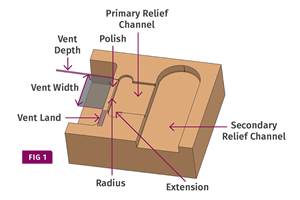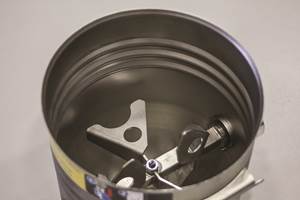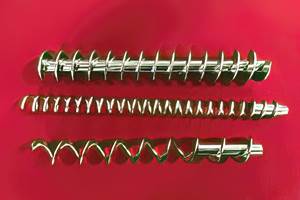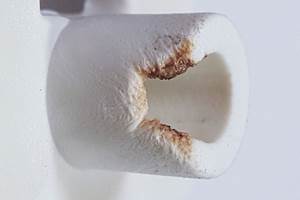Extrusion Cooling: It’s All About Turbulence
Regardless of what you are extruding, in order to maximize cooling you need to generate turbulence at the heat-exchange surface.
Proper cooling in extrusion is critical because it often controls output. Extruded parts can be cooled by gases, liquids, or contact with a heat-absorbing surface such as chill rolls or calibrators. Profiles, pipe, tubing, and cable jacketing are generally water cooled; other types of extrusions (such as blown film) are cooled by air or gases, either entirely or partially. Many of the same techniques that are used to optimize cooling in other processes, notably molding, apply to extruded products as well. One of the most significant is the need for turbulence of the coolant at the surface of the extrusion. When water or a gas flows at low velocity it forms layers. This is called laminar flow. Under laminar flow, the heat-transfer rate equals the surface area times the temperature differential divided by the distance from the surface. This means there is a temperature gradient from the surface outward into the coolant.
With laminar flow, the coolant layer nearest the extrusion, often called a boundary layer, has a low velocity because of its drag on the extrudate surface. Consequently it becomes hotter than the surrounding coolant. Since heat flow from the surface of the extrudate is proportional to the difference in temperature between the extrusion and the coolant, the hotter layer at the surface of the extrudate reduces the overall heat transfer.
Greater coolant velocity creates turbulence in the boundary layer and mixes the main body of the coolant with the boundary layer near the extrudate surface. Additionally, turbulence at the extrudate’s surface reduces drag. Finally, increased velocity moves the hotter coolant away from the extrudate. So, an important aspect of heat transfer is the velocity of the water or gas near the surface of the extrudate or tooling component. It can be more important than the actual temperature of the coolant. Turbulent flow increases convective heat transfer, increases mass transfer and mixing, and reduces drag, all of which are all favorable to increased cooling of the extrudate.
Reynolds numbers (Re) below 1000 are considered indicative of laminar flow. Numbers ranging from 1000 to 10,000 are considered a transition zone, and beyond that is turbulent flow. Turbulence is determined by calculating the Reynold’s number as follows:
Re= udn/V
u = velocity, dn = hydraulic diameter, and V = kinematic viscosity.
In the accompanying graph, the Re is compared with the Nusselt number, which is a ratio of convection to conduction heat transfer, for a corrugated and a smooth tube. A higher Nusselt number indicates increased convective heat transfer.
Comparing the Nusselt number at Re = 1000 to Re = 3000 shows an increase of more than two times the convective heat transfer. It would require a significant change in water temperature to match the effect of turbulence.
How do you apply this to your process? Each process has to be treated a little differently, but with the same goal—to achieve turbulence at the heat-exchange surface to maximize heat transfer. For example, in a chill roll for sheet/cast film, cooling turbulence is created in the spiral wraps to cool the shell. For blow molds, turbulence is generated in the water passages of the mold. In profile tooling, turbulence is established in calibration tooling.
In processes where the tooling does the cooling, the Re can be used to size the cooling channels and even the velocity in the surface film in the calibration tooling. However, in large cooling tanks it’s more difficult to establish turbulent flow. So for pelletizing, pipe, tubing, and some profile applications, it may be hard to significantly increase the velocity of the cooling water to the turbulent range. In those cases you can use jets, bubblers, or baffles to generate the localized velocity necessary to break up the boundary layer.
Even though the temperature of the overall mass of water may remain low, the invisible boundary layer and its temperature gradient surrounding the extrudate restrict heat transfer.
ABOUT THE AUTHOR: Jim Frankland is a mechanical engineer who has been involved in all types of extrusion processing for more than 40 years. He is now president of Frankland Plastics Consulting, LLC. Contact jim.frankland@comcast.net or (724)651-9196.
Related Content
Back to Basics on Mold Venting (Part 2: Shape, Dimensions, Details)
Here’s how to get the most out of your stationary mold vents.
Read MoreFive Quick Steps Toward Better Blending
Rising costs of resins and additives, along with higher demands for quality and use of regrind, place a premium on proficient blending. Here are some steps to get you there.
Read MoreWhat to Know About Your Materials When Choosing a Feeder
Feeder performance is crucial to operating extrusion and compounding lines. And consistent, reliable feeding depends in large part on selecting a feeder compatible with the materials and additives you intend to process. Follow these tips to analyze your feeder requirements.
Read MoreBack to Basics on Mold Venting (Part 1)
Here’s what you need to know to improve the quality of your parts and to protect your molds.
Read MoreRead Next
Making the Circular Economy a Reality
Driven by brand owner demands and new worldwide legislation, the entire supply chain is working toward the shift to circularity, with some evidence the circular economy has already begun.
Read MoreSee Recyclers Close the Loop on Trade Show Production Scrap at NPE2024
A collaboration between show organizer PLASTICS, recycler CPR and size reduction experts WEIMA and Conair recovered and recycled all production scrap at NPE2024.
Read MoreFor PLASTICS' CEO Seaholm, NPE to Shine Light on Sustainability Successes
With advocacy, communication and sustainability as three main pillars, Seaholm leads a trade association to NPE that ‘is more active today than we have ever been.’
Read More.jpg;width=70;height=70;mode=crop)











